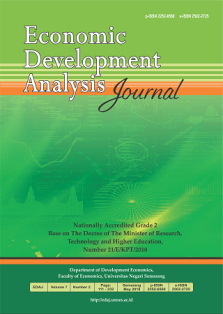A Multidimensional Optimum Ecotope Base Algorithm Labour Central Java
Abstract
The workforce of Central Java Province in 2019 as many as 18.26 million has the potential to
increase the economic growth of Central Java Province by increasing Labour productivity. Labour
productivity will increase through the role of education and health. Education and health of workers,
which are components of human capital, which in fact are inherent in the workforce. Problems will
arise when the workforce experiences health problems. The purpose of this study was to analyze the
spatial interaction patterns of Labour in Central Java Province. This research method uses the
Multidirectional Optimum Ecotope Base Algorithm (AMOEBA) approach to analyze the spatial
interaction patterns of the workforce of Central Java Province by using a spatial weight matrix of
euclidean distances. This study uses spatial panel data from 29 districts and 6 cities in Central Java
Province from 2014 to April 2020. The results of this study indicate the variables that affect the
economic growth of Central Java Province are spatial lag (ρ), capital, average length of schooling
(RLS), spatial weight matrix with Euclidean Distance Labour with ρ value less than 5%. The results
of this study showed that there was a strong change in the spatial interaction pattern of the workforce
between 2014 and April 2020. Initially in 2014 there were 11 districts / cities with strong spatial
interaction patterns of Labour, then in April 2020 there were only 5 districts city. The strong spatial
interaction pattern of Central Java's workforce has decreased in April 2020, presumably due to
government policies regarding activity restrictions in the form of social distancing and physical
distancing policies.


